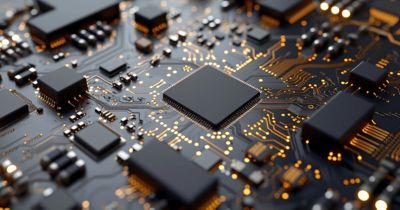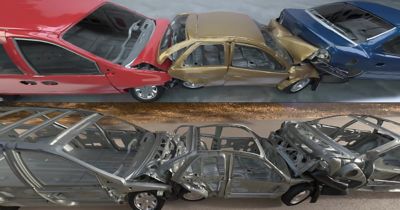-
United States -
United Kingdom -
India -
France -
Deutschland -
Italia -
日本 -
대한민국 -
中国 -
台灣
-
Ansys is committed to setting today's students up for success, by providing free simulation engineering software to students.
-
Ansys is committed to setting today's students up for success, by providing free simulation engineering software to students.
-
Ansys is committed to setting today's students up for success, by providing free simulation engineering software to students.
-
Contact Us -
Careers -
Students and Academic -
For United States and Canada
+1 844.462.6797

Racing is inherently dangerous. Thanks to virtual modeling in a simulation environment, the risk of serious driver injuries remains low.
NASCAR drivers are some of the best in the world. But when you’re driving on the edge of traction at 200 miles per hour, crashes are bound to happen. John Patalak, vice president of safety at NASCAR, is keenly aware of the potential risks. To help maintain safety during racing season, his team leans on massive amounts of data acquired on the track, as well as data acquired in a simulation environment.
“From a speed standpoint, one of the things we’re trying to always improve on is being able to respond faster to safety issues,” he says. “Our drivers expect and demand that from us. We have to be fully confident that we have data to stand on if we’re going to tell the driver to take some action to be safer. We can’t do that solely based on opinion, but because we’ve got data that we’re confident in and is robust enough to make that decision on, so we can sleep at night.”
While NASCAR drivers experience more crashes per mile than those in passenger cars do, the rate of injury per crash on the track is far less, according to Patalak. One particular driver injury NASCAR is studying is compression fractures between the thoracic and lumbar vertebral bodies of the spine.
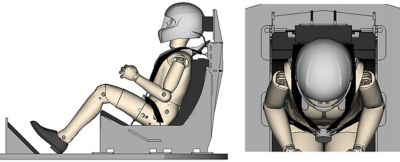
Helmet foam simulation, rear impact, THUMS 50th percentile male
To understand these types of injuries, NASCAR relies on a combination of test data using an anthropomorphic test device (ATD) or crash test dummy, and numerous virtual simulations in Ansys LS-DYNA, which is multiphysics structural dynamic simulation software.
These virtual simulations also involve the use of the THUMS (Total Human Model for Safety) from Toyota, a digital representation of a human body which helps the team do more thorough spinal injury risk assessments during frontal impacts than with a mechanical dummy alone.
“We’ve done a lot of research into these types of injuries,” says Patalak. “You can have a mechanical model. You can test it. You can validate it. Without simulation, you’re really limited with empirical testing and physical crash test dummies for this specific injury mechanism. The crash test dummies do have lumbar load cells, but their spines are not very biofidelic, so we quickly get to the limits of those tools. Using human modeling in a simulation environment transcends these limitations.”
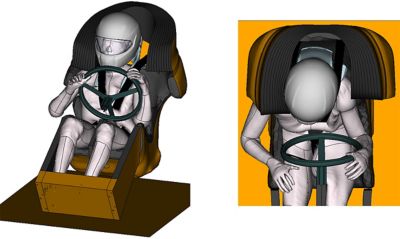
Helmet foam simulation, right-side impact, THUMS 50th percentile male
Still, You Can Learn a Lot From A Dummy
Aside from any limitations, NASCAR’s baseline for testing is the ATD. The dummy model helps the team validate its restraint system models. To do this, the team must reference material models of seat belt systems, seat foams, the helmet, and the HANS device (a head and neck support device or yolk-like collar tethered to the helmet that is positioned under the driver’s shoulder belts).
Before any digital modeling is done, the team empirically tests the mechanical dummy with all the relevant pieces of safety equipment. This entire setup is digitally recreated in LS-DYNA software to look at all the sensor outputs on the dummy, as well as other physical parts.
Validation against the empirical dummy gives the team a higher level of confidence in the virtual representation of seat belts, helmets, head and neck restraints, and seat foams that are touching the dummy. Once the team has those pieces, it can remove the ATD from the virtual environment and start to look at much more detailed and nuanced issues from injury mechanisms with the human body model.
Based on this activity, NASCAR engineers can tweak the restraint system, such as the stiffness of the foam the human body model is on or the angles of the seatbelt to realize incremental improvements. As of late, the team is examining the posture of the human body model pre-impact. This includes turning on some of the musculature in the model to activate a bracing posture (with the help of a high-speed video of real drivers during a crash) to get an idea of how a driver is positioning his or her body pre-crash.
“If you have a thoracolumbar spinal fracture, the dummy has a somewhat limited output set to help us understand that specific injury mechanism,” Patalak says. “So the reason we went to the human body model is because we can look at localized strains on each vertebral body and start to compare those strains to failure strains of an area of the spine. We can also look at cross-sectional forces through each vertebral body and the bending moments so we can extract all of that information to optimize the system overall.”
Crash dummy empirical and numerical sled testing comparison
Ansys Software Gives Engineers a Heads-Up on Helmet Performance
Five key safety improvements in NASCAR have been identified as lifesavers on the track:
- Black boxes for crash data
- Full-face helmets
- HANS devices
- Steel and foam energy reduction barriers
- Improved seat belts and seats
Among them, full-face helmets get the most attention for their colorful appearance and ability to protect a driver’s head during a race. By design, they are engineered to distribute the force of a crash across the entire head and protect drivers from facial injury during high-speed impacts.
Just how well do helmets do their job during a NASCAR race? According to Patalak, it’s rare that a driver experiences a severe impact to the helmet shell itself. That’s because NASCAR drivers are pretty well contained within full-head surrounds and a roll cage over them. Still, there’s always room for improvement.
One area the team has been looking to squeeze out a bit more performance from the helmet is in the area of low-severity impacts. The objective is to balance safety with driver expectations in an environment that can be noisy, harsh, and even claustrophobic. Drivers want to be very well-coupled — engineering speak for attached to the car (which is very beneficial from a safety standpoint) — through the driver’s seat and energy-absorbing foam.
In the cockpit, a driver’s helmet is surrounded by crash foam, which, while minimizing crash injury risks for the head and neck, can be problematic for regular driving. As drivers go over bumps and curbs, they may get jostled from left to right, causing impacts between their heads and the crash foam. One area of focus for the team is to explore and understand these low-severity impacts between the helmet and the head surround foam that can become uncomfortable during a race.
“To replicate this phenomenon, we have characteristic pulses that we run against head foam models through the system to see how the human body model head responds,” says Patalak. “Then we look at modifying material properties within the helmet or the head foam within the context of our simulation environment to lessen the effects of these impacts.”
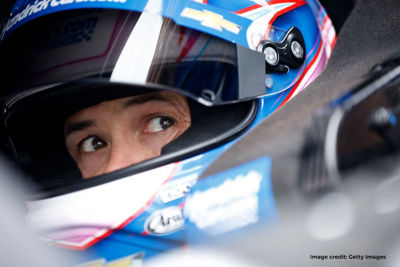
Safer Seasons Ahead With Simulation
Any testing efforts in helmet development are part of a long-term study at NASCAR. Currently, the team is modeling in LS-DYNA simulation software to try to develop empirical tests. The intention is to develop tests that helmet manufacturers or standard-bearers, including the Snell Memorial Foundation and the FIA, or Fédération Internationale de l’Automobile, can use to evaluate helmet efficacy at lower severity levels.
Both Snell and the FIA work in evaluating, testing, and regulating motorsport helmets. In sharing its work with both organizations, NASCAR is on track to make a difference in motorsport safety, as not everyone is fortunate to have access to full LS-DYNA models of their helmet systems.
Patalak’s team is also examining what adjustments to the HANS tethers that the helmet is attached to can be made to better protect the driver. Research includes the effect of tether length, height, and angles on upper and lower neck loads. The idea is to find the sweet spot within a modeling environment that will significantly reduce head acceleration without increasing neck forces upon impact. In the end, it’s work that would otherwise be severely limited, if not impossible, without simulation.
“I think the value of the LS-DYNA simulations is that we can set aside the inherent small variabilities of physical testing and really assess the effects of minute changes to a system with a high level of confidence much, much faster and cheaper,” Patalak says. “It’s hard to estimate the software’s real value because, in many cases, what we’re able to do in LS-DYNA simulations is just not possible without it.”
Learn More
Just for you. We have some additional resources you may enjoy.
“It’s hard to estimate the software’s real value because, in many cases, what we’re able to do in LS-DYNA simulations is just not possible without it.”
— John Patalak, vice president of safety, NASCAR
The Advantage Blog
The Ansys Advantage blog, featuring contributions from Ansys and other technology experts, keeps you updated on how Ansys simulation is powering innovation that drives human advancement.













